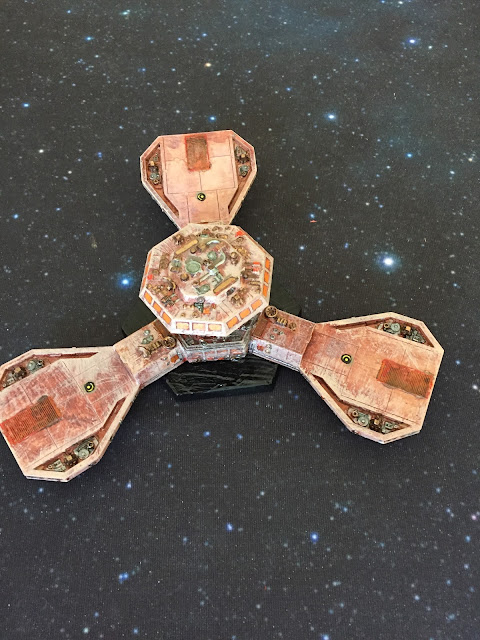First Thoughts on the Hydrans
Now that the Hydrans have made their appearance in the campaign, it is worth some thought as to how they play in my solo fast fleet rules. This is because I had no idea how they would work out in practice, simply because their ships are so radically different from anyone else's; consequently, so too is my feel for their overall combat doctrine. It's made even more complicated by the fact that not only do they have three different kinds of ships (fusion, hellbore and command ships that carry both), they also have their fighters. These again are different from what has gone before because they use heavy direct fire weapons instead of drone missiles.
So far I've played with a fusion fleet and a hellbore fleet; it will be interesting to see how things develop as the war progresses, probably with mixed fleets starting to appear as the losses start to bite and tidy formations and organisations become a thing of the past - well, that's what happens when you are fighting for your life. Conversely, the problem for the Lyrans is that their forces on the Hydran Front are relatively few in number and almost entirely comprised of expensive twin-hulled ships. This is because the Enemy's Blood and the reinforcing Far Stars fleet have been left to get on with what they have while the newer designs are sent to the Kzinti Front to aid in the invasion.
Losses in the Hydran attack make rather startling reading once you start to analyse them. The Lyrans are exceptional ships and their fleets dish out loads of damage. This is because not only are they excellent designs, but they carry more Phaser-1s than their Klingon counterparts, plus they have the ESG fields. The Hydrans, of course, soak most of this up with their omnipresent fighters. An engagement between these two adversaries is therefore probably more interesting than what happens between enemies that are both armed with disruptors - or perhaps it just feels this way because it is a different combination. It certainly feels fresher.
Almost every single Hydran fighter was destroyed across the three battles I played against the Lyrans. However, these cost nothing to replace. The actual economic cost of the damage will make sobering reading for any Lyrans out there. In total, the cats lost a Heavy Cruiser; two Light Cruisers; and a Battle Station destroyed. They also had three Frigates crippled. The Hydrans lost a Lancer Destroyer, with a Ranger Cruiser, a Crusader Frigate Leader and a Cuirassier Hellbore Frigate crippled. Assuming that both sides repair the cripples at standard rates at permanent bases (as opposed to double-cost field repairs), the cost to the Lyrans is 48 economic points; for the Hydrans it is 11.5. Thinking as a Hydran, I would take that ratio any day. To put it another way, 48 points is approximately one third of the entire Lyran wartime economy in a six-month turn. And that is in only three engagements.
What this suggests is that the Hydrans are going to be even more vicious than the Kzinti once they go onto the defensive around fixed installations, and the cost of defeating them is going to be horrific for the Coalition. It will also be a while before the Coalition offensive gets under way properly, because the Lyrans are going to have to shift their attention to this theatre and build up their forces accordingly. The larger Klingon navy will probably get going first, although of course their vessels are not nearly so powerful as their Lyran counterparts.
Next up will be Hydran attacks on two Klingon Battle Stations, and I am looking forward to seeing how the Klingons fare, especially now that I have seen the interaction with the Lyrans. My feeling is that Klingons will be rather more up against it, because of their use of drone missiles as opposed to ESGs. But they do have more ships and, importantly, have invested in more fighters than the Lyrans. These won't last long against Hydran Stingers, of course, but they will help to absorb punishment that otherwise would be going on ships.
One final element of my games that is worth taking into account is that I am using Federation & Empire to generate fleet games for Star Fleet Battles, using my fast play solo rules. This means that there is in effect a third damage step. F&E really has only two states for damaged ships: crippled or blown. You can if you like keep track of odd factors of damage here and there, but that just adds to the record keeping. Playing the games with a version of SFB introduces an earlier stage of hurt, which is that ships can be so heavily damaged that they need to warp out before being crippled or, more likely, destroyed. A ship in this situation has taken so much damage that putting it back in again later, say in another round against a base or planet, would basically be signing its death warrant. So ships like this are considered too heavily damaged to risk, and a bit too mangled to be brought up to par by on the spot repairs. They are effectively out of combat until they can be repaired after the fighting. In effect, this helps the interface between the strategic map game and the tabletop tactical combat game. They don't cost anything to repair when they do get the chance, unlike crippled ships, but an extra damage step helps the 'realism' of the game. It makes attrition really important!



Comments
Post a Comment